CREE LED 热设计 Thermal Manager
CREE科瑞芯片
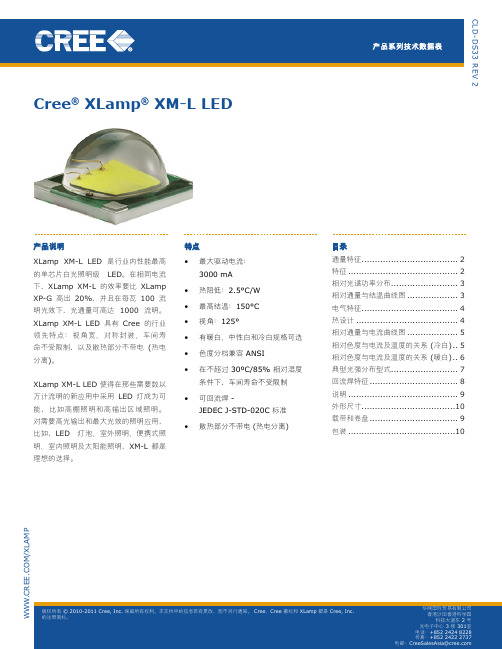
相对色度与电流及温度的关系 (冷白)
XLAMP XM-L LED
相对色度与电流及温度的关系 (暖白)
Copyright © 2010 Cree, Inc. All rights reserved. The information in this document is subject to change without notice. Cree, the Cree logo and XLamp are registered trademarks o版f权C所re有e, I©nc2.010-2011 Cree, Inc. 保留所有权利。本文档中的信息若有更改,恕不另行通知。 Cree、Cree 徽标和 XLamp 都是 Cree, Inc. 的注册商标。
热设计....................................... 4
相对通量与电流曲线图.................... 5
相对色度与电流及温度的关系 (冷白)... 5
相对色度与电流及温度的关系 (暖白)... 6
典型光强分布型式.......................... 7
3
电气特征 (TJ = 25°C)
XLAMP XM-L LED
热设计
最大正向电流由 LED 结合处和环境之间的热阻决定。最终产品的设计方式必须能够将焊点到环境的热阻减至最小,以便延长灯的使用寿命, 优化光学特征,这一点非常重要。
Copyright © 2010 Cree, Inc. All rights reserved. The information in this document is subject to change without notice. Cree, the Cree logo and XLamp are registered trademarks o版f权C所re有e, I©nc2.010-2011 Cree, Inc. 保留所有权利。本文档中的信息若有更改,恕不另行通知。 Cree、Cree 徽标和 XLamp 都是 Cree, Inc. 的注册商标。
高功率LED照明设计中的散热控制方案

高功率LED照明设计中的散热控制方案2010年12月12日来源:电子发烧友[责任编辑:Aglaia]中心议题:LED照明中的热量产生原因高功率LED照明设计中的散热设计解决方案:利用热敏电阻的LED做散热控制热敏电阻与线性或开关稳压器一起使用时与白炽灯钨丝灯泡不同,高功率LED不辐射热量。
与之相反,LED将其PN结的热量传导到LED封装的散热金属小块上。
由于LED产生的热量采用传导方式散发,因此这些热量需要一个更长、更昂贵的路径才能完全散发到空气中去。
目前HBLED通用照明的一个最大商业化障碍就是其散热问题,因此能否彻底有效地解决这问题可以说是赢得客户的关键。
本文将为你分享Zetex的LED照明专家在解决散热问题时的独到经验。
在迅速发展的LED照明设计中,大多数人将注意力集中在高亮度(HB)LED的调光控制策略上。
不过,HBLED照明应用的本质要求我们将更多的注意力转移到散热控制上。
虽然LED制造商通过大幅提高每瓦的流明数正在降低HBLED照明设计的技术障碍,但与光输出相比,仍有更多的电能转化为要散发出去的热量。
因此需要一个散热管理的总体战略,以确保LED散发的热量可控制为一个温度的函数。
图1中曲线显示了1WLED的典型性能下降特性。
正如所期望的那样,这清楚地表明,被恒定电流驱动的LED在到达某一点后,该恒流需要线性地减少,直到在150℃这一点上达到0。
恒流下降点和减小斜率取决于机械/散热安排。
因此电子控制电路必须能够处理触发点设置和增益设置。
另外需要记住的很重要一点是,事实上LED需要能够应付三个潜在的散热源:自发热、环境温度和LED电子控制。
如果LED照明采用的是远程电子控制,那么这将不是一个问题,不过EMC可能是一个问题。
如果我们再去翻教科书的话,我们会发现控制LED的第一个和最明显的方法是通过一个电阻。
虽然这是一个低成本的方法,但它不可避免地会导致功率损耗,而这否定或削弱了LED的关键效率属性。
解决LED热管理难题
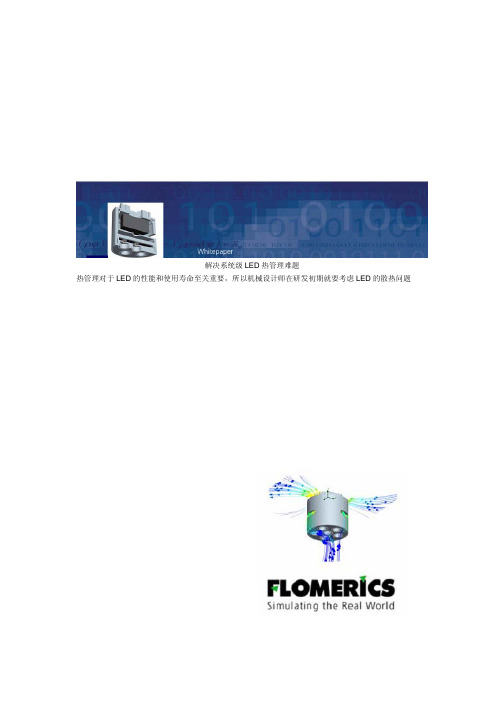
解决系统级LED热管理难题热管理对于LED的性能和使用寿命至关重要,所以机械设计师在研发初期就要考虑LED的散热问题美国能源部(DOE)对LED做出了如下评价:没有其它照明技术可以具有像LED这样大的节能潜力和提升我们建筑环境品质。
由于LED的使用寿命是结温的函数,所以热管理对于LED的性能至关重要。
位于California,San Jose的Philips Lumileds Lighting应用技术经理Rudi Hechfellner说:“到目前为止热管理是LED系统设计最重要的一个方面。
LED系统生产商通过寻求优化的散热器、高效印制电路板、高热导率外壳和其它先进热设计技术来应对这一挑战。
由于热仿真可以在物理模型建立之前,从散热的角度评估不同设计方案和优化系统级设计,所以热仿真的作用日益凸现。
”LED照明的出现固态发光是一项新兴的技术,其会在将来从根本上改变照明的形式。
LED设计之初的功率小于50毫lm Watt。
除了能效高之外,LED的使用寿命也长。
瓦。
在过去十年间,LED的功率已经上升为40~80/根据不同的制造和类型,白色LED的使用寿命可以处于6000~50000小时范围内,高于30000小时的荧光(灯)管和2000小时的白炽灯泡。
此外,LED可以不使用过滤器就产生单色光。
市场分析公司Yole Developpement 说:LED在固态发光市场的收入将由2007年的10亿美元上升到2012年的103亿美元。
Yole 预计在2012年高亮度和超高亮度结合的LED收入将达到44.5亿美元,这是2007年7亿8千万的5.5倍。
这些固态发光装置已经成为不同应用场合的灯源选择,这些应用场合包括交通信号灯、汽车和卡车的内部和外部灯、屏幕可见显示器、小型LCD背后照明和装饰照明。
最新的Isuppli报告(参考1)显示,在一些新的场合也陆续的采用了LED。
散热挑战与其它的灯源相比,高功率的LED产生了严重的散热问题,这主要是因为LED不通过红外辐射进行散热。
大功率LED照明模块及高效散热结构优化设计
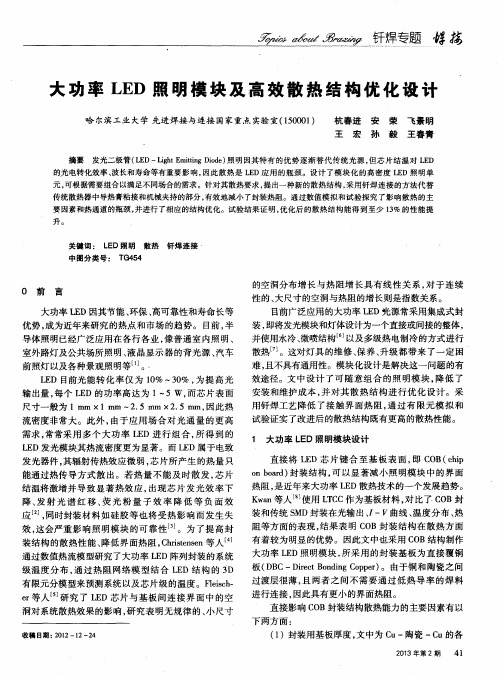
直接将 L E D芯片键合 至基板表 面 , 即C O B ( c h i p o n b o a r d ) 封装结构 , 可 以显 著 减 小 照 明模 块 中的 界 面
热阻 , 是 近 年来 大功 率 L E D散热 技术 的一 个发 展趋 势 。 K w a n等 人 使 用 L T C C作 为基 板材 料 , 对 比了 C O B封
大功率 L E D因其节能 、 环保 、 高可靠性和寿命长等
优势 , 成为 近年来 研究 的热 点 和 市场 的趋 势 。 目前 , 半 导 体照 明 已经广 泛应 用 在各 行 各业 , 像 普通 室 内照 明 、
目前广泛应用的大功率 L E D光源常采用集成式封 装, 即将发光模块和灯体设计为一个直接或间接的整体 , 并使用水冷、 微喷结构 以及多级热电制冷的方式进行 散热 。这对灯具 的维修 、 保养 、 升级都带来 了一定 困 难, 且不具有 通用性 。模 块化 设计 是 解决 这 一 问题 的有
流密 度非 常 大 。 此 外 , 由于 应 用 场 合 对 光 通 量 的 更 高
安装和维护成本 , 并对其散 热结构进行优化设计 。采
用 钎焊 工 艺 降低 了接 触 界 面 热 阻 , 通 过 有 限元 模 拟 和
试验证实了改进后的散热结构既有更高的散热性能。
1 大功 率 L E D照 明模块 设计
效 途径 。文 中设 计 了 可 随 意 组 合 的 照 明模 块 , 降低 了
led论散热
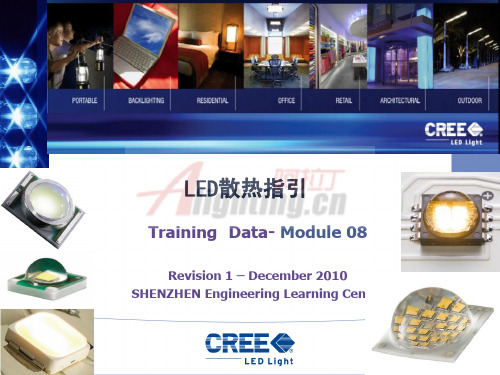
Copyright © 2008, Cree, Inc. pg. 22
散热器的计与选择
高效能的散熱 =熱傳係數X散熱面積X溫度差
*熱傳係數: 材料性質,幾何形狀, 流場狀況(层流,紊流) *散熱面積: 製造加工方式,幾何形狀 *溫度差: 幾何形狀,流場狀況
Copyright © 2006, Cree, Inc.
散热材质的选用
散热主要用AL的特性参数 比重 g/cm3 彈性率 kg/mm2 X 103 剛性率 kg/mm2 X 103 溶融溫度範圍 比熱 (0~100 oC) cal /g •oC
1050 2.7 7.0 2.7 650 - 660 oC 0.22 24 0.5 209.5 0.0282 -
Copyright © 2008, Cree, Inc.
pg. 10
LED的热管理
解决方法:
(A)改进LED芯片、封装的 结构和材料;
——上中游产业完成
(B)系统集成,主要针对灯 具散热方式,提高换热 功率。 ——散热设计的工作
散热设计 研究方向
Copyright © 2008, Cree, Inc.
6063 2.71 7.0 2.7 600 - 650 oC 0.21 23.4 0.48 201.12 0.033 53
6061 2.71 7.0 2.7 580 - 650 oC 0.22 23.6 0.37 155.03 0.043 40
pg. 24
2024 2.77 7.5 2.9 500 - 640 oC 0.22 23.2 0.29 121.51 0.057 30
Copyright © 2008, Cree, Inc.
LED灯具的热分析与散热设计
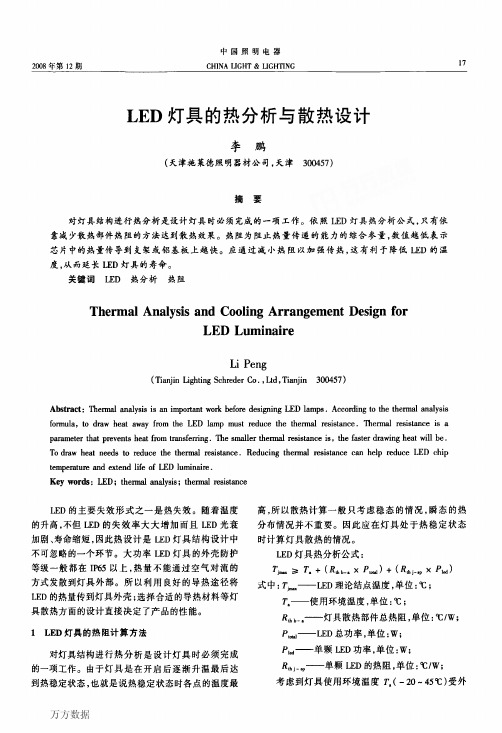
万方数据
18
中国照明电器
2008年第12期
部条件限制一般是不可控的,另外为满足照明效果 LED灯具总功率P训、单颗LED功率P。甜在设计前应 已经确定不可更改,最后单颗LED的热阻目前一般 为8。C/W。依照LED灯具热分析公式,只有依靠减小 灯具散热部件热阻的方法达到散热效果。
下面以一个有16颗LED(1W、CREE品牌XR.E 系列)的灯具为实例进行计算。
formula,to draw heat away from the LED lamp must reduce the thermal resistance.Thermal resistance is a
parameter that prevents heat from transferring.The smaller thermal resistance is,the faster drawing heat will be.
由以上计算可以得出:散热部件热阻R山。一。≤ 5.182。C/W时灯具才可以在45℃的外部环境中使用。
2 LED灯具结构的热分析
热的传递方式有热传导、热辐射、热对流。对大 功率LED照明灯具而言热传导方式起最主要的作
用,因此LED灯具的热分析主要考虑热量在灯具内 部以热传导方式传递时的散热效果。
热阻是指热量传递通道上两个参点之间的温度 差与两点间热量传输速率的比值,单位为℃/w。热 阻为阻止热量传递的能力的综合参量,应通过减小热 阻以加强传热。当热量在物体内部以热传导的方式 传递时,遇到的热阻称为导热热阻;热量流过两个相 接触的固体的交界面时,界面本身对热流呈现出明显 的热阻称为接触热阻。因此我们考虑的热阻包括导 热热阻和接触热阻。产生接触热阻的主要原因是,任 何外表上看来接触良好的两物体,直接接触的实际面 积只是交界面的一部分,其余部分都是缝隙。热量依 靠缝隙内气体的热传导和热辐射进行传递,而气体的 传热能力远不及一般的固体材料。接触热阻使热流 流过交界面时,沿热流方向温度发生突然下降,这是 灯具设计中需要尽量避免的现象。
LED背光照明与散热技术
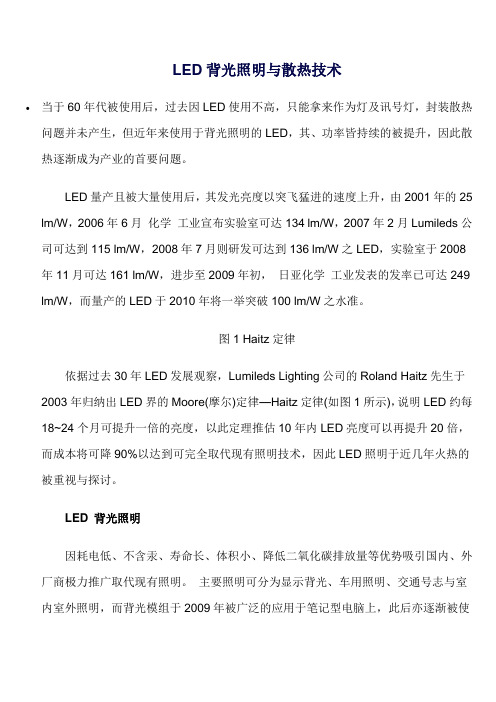
LED背光照明与散热技术当于60年代被使用后,过去因LED使用不高,只能拿来作为灯及讯号灯,封装散热问题并未产生,但近年来使用于背光照明的LED,其、功率皆持续的被提升,因此散热逐渐成为产业的首要问题。
LED量产且被大量使用后,其发光亮度以突飞猛进的速度上升,由2001年的25 lm/W,2006年6月化学工业宣布实验室可达134 lm/W,2007年2月Lumileds公司可达到115 lm/W,2008年7月则研发可达到136 lm/W之LED,实验室于2008年11月可达161 lm/W,进步至2009年初,日亚化学工业发表的发率已可达249 lm/W,而量产的LED于2010年将一举突破100 lm/W之水准。
图1 Haitz定律依据过去30年LED发展观察,Lumileds Lighting公司的Roland Haitz先生于2003年归纳出LED界的Moore(摩尔)定律—Haitz定律(如图1所示),说明LED约每18~24个月可提升一倍的亮度,以此定理推估10年内LED亮度可以再提升20倍,而成本将可降90%以达到可完全取代现有照明技术,因此LED照明于近几年火热的被重视与探讨。
LED 背光照明因耗电低、不含汞、寿命长、体积小、降低二氧化碳排放量等优势吸引国内、外厂商极力推广取代现有照明。
主要照明可分为显示背光、车用照明、交通号志与室内室外照明,而背光模组于2009年被广泛的应用于笔记型电脑上,此后亦逐渐被使用到家用电视机,其约占了50%之面板模组零组件制造成本与消耗约70%显示器之,故背光照明为显示面板最重要的关键。
然显示器无法自行发光,因此需要背光模组作为光线的来源,所以背光源的好坏会影响显示的效果甚剧。
加上面板需薄型化的因素,因此多以灯管作为背光源,而背光源比起CCFL有佳、寿命长、反应速度快等优势(如表1)。
再加上近年来由于全球提倡环保议题,各国政府的禁汞环保政策,如欧盟的WEEE与RoHS指令与中国的电子信息产品生产污染防治管理办法等陆续推行,也驱使小体积封装之LED成为替代CCFL的最佳无汞灯源。
大功率发光二极管的热管理及其散热设计
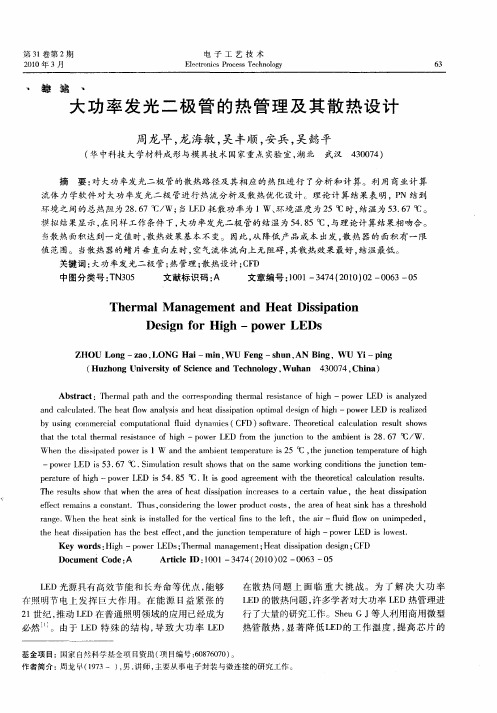
p r t r fh g ~po rLED s 5 8 o e au e o ih we i 4. 5 C.I s g o g e me twi h h o ei a a c l t n r s ls ti o d a r e n t t e t e rtc l c lu a i e u t . h o Th e u t h w h twh n t r a o e td s i ai n i c e s s t et i au e r s ls s o t a e he a e fh a isp t n r a e o a c ra n V l e,t e h a s i ai n o h e tdisp t o ef c e l i sa c n t n .Th s, o sd rn he lwe r d c o t f tr fa n o sa t e l u c n i e i g t o rp o u tc ss,t e a e fhe tsn S at r s o d h r ao a i k ha h e h l r n e W h n te h a i k i n t l d frt e v ri a nst he lf .t e ar—fu d fo o n mp d d。 ag . e h e tsn Si sal o h e e lf o t et h i l i w n u i e e e t i l
Th r a a g m e t a d He t Disp to e m lM na e n n a siain De i n f r Hi h — p we sg o g — o r LEDs
ZHOU ng—z o. Lo a LONG i—mi W U n —s Ha n, Fe g hun, AN ng,W U Bi Yi—pi g n
大功率LED灯的热分析与热设计
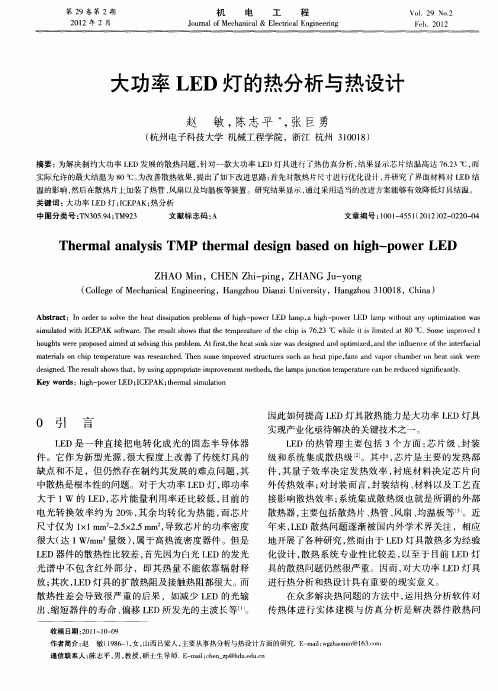
光谱 中不包 含红外部分 ,即其热量不 能依靠辐射释
放; 其次 ,E L D灯具 的扩 散热 阻及接 触 热阻都很 大 。 而 散 热性 差 会 导 致很 严 重 的后果 ,如减 少 L D的光 输 E 出、 缩短 器 件 的寿 命 、 偏移 L D所 发 光 的 主波 长等 …。 E
收 稿 日期 :0 一 O O 2 1 1— 9 J
中图 分 类 号 :N 0 . ;M9 3 T 359 T 2 4 文 献 标 志码 : A 文章 编 号 :0 1 4 5 (0 2 0 — 2 0 0 10 — 5 12 1 )2 0 2 — 4
Th r a n l ss TM P t e m a e i n b s d o i h p we e m la a y i h r l sg a e n h g - o r LED d
பைடு நூலகம்
级 和 系统 集 成 散热 级 ] 中 , 片 是 主 要 的发 热 部 。其 芯 件, 其量 子 效 率 决 定 发热 效 率 , 底 材料 决 定 芯 片 向 衬 外 传热 效率 ; 对封 装 而言 , 装结 构 、 料 以及 丁艺直 封 材
大于 1 的 L D 芯片能量利用率还 比较低 , W E , 目前 的 电光转换效 率约为 2%, 0 其余 均转化为热能 , 而芯片
尺寸仅 为 i l l225 25m , x T ̄ .x . m。导致 芯 片的功 率 密度 m1 很 大 ( l m 级 )属 于 高热 流 密度 器件 。但 是 达 m量 W/ , L D器件 的散 热性 比较 差 , 先 因为 白光 L D的发光 E 首 E
接影响散热效率 ; 系统集成散热级也就是所谓 的外部 散热器 , 主要包括散热片 、 热管 、 风扇 、 均温板等 。近
Cree XLamp XP-L高密度LED和高强度LED产品说明书
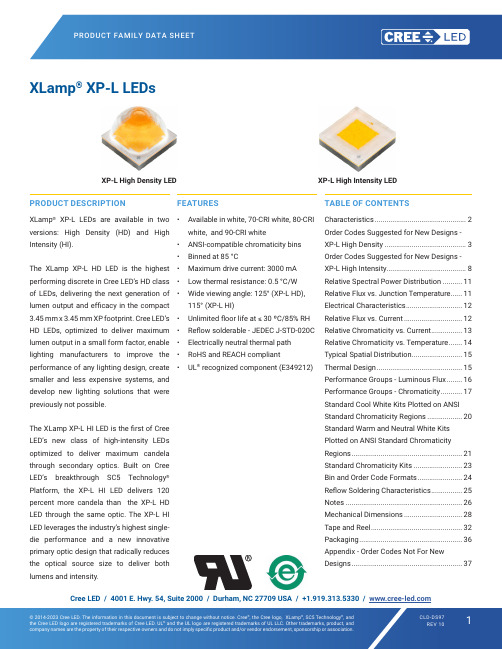
XLamp ®XP-L LEDsXP-L High Density LED XP-L High Intensity LEDPRODUCT DESCRIPTIONXLamp ® XP-L LEDs are available in two versions: High Density (HD) and High Intensity (HI).The XLamp XP-L HD LED is the highest performing discrete in Cree LED’s HD class of LEDs, delivering the next generation of lumen output and efficacy in the compact3.45 mm x 3.45 mm XP footprint. Cree LED’s HD LEDs, optimized to deliver maximum lumen output in a small form factor, enable lighting manufacturers to improve the performance of any lighting design, create smaller and less expensive systems, and develop new lighting solutions that were previously not possible.The XLamp XP-L HI LED is the first of Cree LED’s new class of high-intensity LEDs optimized to deliver maximum candela through secondary optics. Built on Cree LED’s breakthrough SC5 Technology ® Platform, the XP-L HI LED delivers 120 percent more candela than the XP-L HD LED through the same optic. The XP-L HI LED leverages the industry’s highest single-die performance and a new innovative primary optic design that radically reduces the optical source size to deliver both lumens and intensity.FEATURES• Available in white, 70-CRI white, 80-CRIwhite, and 90-CRI white• ANSI-compatible chromaticity bins • Binned at 85 °C• Maximum drive current: 3000 mA • Low thermal resistance: 0.5 °C/W • Wide viewing angle: 125° (XP-L HD), 115° (XP-L HI)• Unlimited floor life at ≤ 30 ºC/85% RH • Reflow solderable - JEDEC J-STD-020C • Electrically neutral thermal path • RoHS and REACH compliant• UL ® recognized component (E349212)TABLE OF CONTENTSCharacteristics ...............................................2Order Codes Suggested for New Designs - XP-L High Density ..........................................3Order Codes Suggested for New Designs - XP-L High Intensity.........................................8Relative Spectral Power Distribution ..........11Relative Flux vs. Junction Temperature ......11Electrical Characteristics .............................12Relative Flux vs. Current ..............................12Relative Chromaticity vs. Current ................13Relative Chromaticity vs. Temperature .......14Typical Spatial Distribution ..........................15Thermal Design ............................................15Performance Groups - Luminous Flux ........16Performance Groups - Chromaticity ...........17Standard Cool White Kits Plotted on ANSI Standard Chromaticity Regions ..................20Standard Warm and Neutral White Kits Plotted on ANSI Standard Chromaticity Regions .........................................................21Standard Chromaticity Kits .........................23Bin and Order Code Formats .......................24Reflow Soldering Characteristics ................25Notes ............................................................26Mechanical Dimensions ..............................28Tape and Reel ...............................................32Packaging .....................................................36Appendix - Order Codes Not For New Designs .........................................................37CHARACTERISTICS* Thermal resistance measurement was performed per the JEDEC JESD51-14 standard. See the Thermal Resistance Measurement application note for more details.Notes• Cree LED maintains a tolerance of ±7% on flux and power measurements, ±0.005 on chromaticity (CCx, CCy) measurements and a tolerance of ±2 on CRI measurements. See the Measurements section (page 26).• XLamp XP-L LED order codes specify only a minimum flux bin and not a maximum. Cree LED may ship reels in flux bins higher than the minimum specified by the order code without advance notice. Shipments will always adhere to the chromaticity bin restrictions specified by the order code.*Flux values @ 25 °C are calculated and for reference only.ORDER CODES SUGGESTED FOR NEW DESIGNS - XP-L HIGH DENSITY (T J = 85 °C)The following tables provide order codes for XLamp XP-L High Density LEDs. For a complete description of the order code nomenclature, please see the Bin and Order Code Formats section (page 24). For definitions of the chromaticity kits, please see the Standard Chromaticity Kits section (page 23).Notes• Cree LED maintains a tolerance of ±7% on flux and power measurements, ±0.005 on chromaticity (CCx, CCy) measurements and a tolerance of ±2 on CRI measurements. See the Measurements section (page 26).• XLamp XP-L LED order codes specify only a minimum flux bin and not a maximum. Cree LED may ship reels in flux bins higher than the minimum specified by the order code without advance notice. Shipments will always adhere to the chromaticity bin restrictions specified by the order code.*Flux values @ 25 °C are calculated and for reference only.ORDER CODES SUGGESTED FOR NEW DESIGNS - XP-L HIGH DENSITY (T J = 85 °C) - CONTINUEDNotes• Cree LED maintains a tolerance of ±7% on flux and power measurements, ±0.005 on chromaticity (CCx, CCy) measurements and a tolerance of ±2 on CRI measurements. See the Measurements section (page 26).• XLamp XP-L LED order codes specify only a minimum flux bin and not a maximum. Cree LED may ship reels in flux bins higher than the minimum specified by the order code without advance notice. Shipments will always adhere to the chromaticity bin restrictions specified by the order code.*Flux values @ 25 °C are calculated and for reference only.ORDER CODES SUGGESTED FOR NEW DESIGNS - XP-L HIGH DENSITY (T = 85 °C) - CONTINUEDNotes• Cree LED maintains a tolerance of ±7% on flux and power measurements, ±0.005 on chromaticity (CCx, CCy) measurements and a tolerance of ±2 on CRI measurements. See the Measurements section (page 26).• XLamp XP-L LED order codes specify only a minimum flux bin and not a maximum. Cree LED may ship reels in flux bins higher than the minimum specified by the order code without advance notice. Shipments will always adhere to the chromaticity bin restrictions specified by the order code.*Flux values @ 25 °C are calculated and for reference only.ORDER CODES SUGGESTED FOR NEW DESIGNS - XP-L HIGH DENSITY (T = 85 °C) - CONTINUEDNotes• Cree LED maintains a tolerance of ±7% on flux and power measurements, ±0.005 on chromaticity (CCx, CCy) measurements and a tolerance of ±2 on CRI measurements. See the Measurements section (page 26).• XLamp XP-L LED order codes specify only a minimum flux bin and not a maximum. Cree LED may ship reels in flux bins higher than the minimum specified by the order code without advance notice. Shipments will always adhere to the chromaticity bin restrictions specified by the order code.*Flux values @ 25 °C are calculated and for reference only.ORDER CODES SUGGESTED FOR NEW DESIGNS - XP-L HIGH DENSITY (T = 85 °C) - CONTINUEDNotes• Cree LED maintains a tolerance of ±7% on flux and power measurements, ±0.005 on chromaticity (CCx, CCy) measurements and a tolerance of ±2 on CRI measurements. See the Measurements section (page 26).• XLamp XP-L LED order codes specify only a minimum flux bin and not a maximum. Cree LED may ship reels in flux bins higher than the minimum specified by the order code without advance notice. Shipments will always adhere to the chromaticity bin restrictions specified by the order code.*Flux values @ 25 °C are calculated and for reference only.ORDER CODES SUGGESTED FOR NEW DESIGNS - XP-L HIGH INTENSITY (T J = 85 °C)The following tables provide order codes for XLamp XP-L High Intensity LEDs. For a complete description of the order code nomenclature, please see the Bin and Order Code Formats section (page 24). For definitions of the chromaticity kits, please see the Standard Chromaticity Kits section (page 23).Notes• Cree LED maintains a tolerance of ±7% on flux and power measurements, ±0.005 on chromaticity (CCx, CCy) measurements and a tolerance of ±2 on CRI measurements. See the Measurements section (page 26).• XLamp XP-L LED order codes specify only a minimum flux bin and not a maximum. Cree LED may ship reels in flux bins higher than the minimum specified by the order code without advance notice. Shipments will always adhere to the chromaticity bin restrictions specified by the order code.*Flux values @ 25 °C are calculated and for reference only.ORDER CODES SUGGESTED FOR NEW DESIGNS - XP-L HIGH INTENSITY (T = 85 °C) - CONTINUEDNotes• Cree LED maintains a tolerance of ±7% on flux and power measurements, ±0.005 on chromaticity (CCx, CCy) measurements and a tolerance of ±2 on CRI measurements. See the Measurements section (page 26).• XLamp XP-L LED order codes specify only a minimum flux bin and not a maximum. Cree LED may ship reels in flux bins higher than the minimum specified by the order code without advance notice. Shipments will always adhere to the chromaticity bin restrictions specified by the order code.*Flux values @ 25 °C are calculated and for reference only.ORDER CODES SUGGESTED FOR NEW DESIGNS - XP-L HIGH INTENSITY (T = 85 °C) - CONTINUEDRELATIVE SPECTRAL POWER DISTRIBUTIONRELATIVE FLUX VS. JUNCTION TEMPERATURE (IF = 1050 m A)ELECTRICAL CHARACTERISTICS (T J = 85 °C)RELATIVE FLUX VS. CURRENT (T J= 85 °C)RELATIVE CHROMATICITY VS. CURRENT (WARM WHITE)RELATIVE CHROMATICITY VS. TEMPERATURE (WARM WHITE)TYPICAL SPATIAL DISTRIBUTIONTHERMAL DESIGNThe maximum forward current is determined by the thermal resistance between the LED junction and ambient. It is crucial for the end product to be designed in a manner that minimizes the thermal resistance from the solder point to ambient in order to optimize lamp life and optical characteristics.PERFORMANCE GROUPS - LUMINOUS FLUXXLamp XP-L LEDs are tested for luminous flux and placed into one of the following luminous-flux groups:PERFORMANCE GROUPS - CHROMATICITYPERFORMANCE GROUPS - CHROMATICITY (CONTINUED)PERFORMANCE GROUPS - CHROMATICITY (CONTINUED)5000 K5700 K6500 K8000 K0A0B0C0D0R0S0T0U1A1B 1C1D2A2B2C2D3A3B1R1S1T1U2R2S2T2U3R3S0.280.290.300.310.320.330.340.350.360.370.380.390.400.280.290.300.310.320.330.340.350.36C C yCCxANSI C78.377A505000 K5700 K6500 K8000 K0A0B0C0D0R 0S0T0U1A 1B 1C1D2A2B2C2D3A 3B1R1S1T1U2R2S2T2U 3R3S0.280.290.300.310.320.330.340.350.360.370.380.390.400.280.290.300.310.320.330.340.350.36C C yCCxANSI C78.377A510.280.290.300.310.320.330.340.350.360.370.380.390.400.20.20.30.30.30.30.30.30.3C C yCCx5000 K5700 K6500 K8000 K0A0B0C0D0R0S0T0U1A1B1C1D2A2B2C2D3A 3B1R1S1T1U2R2S2T2U 3R3S0.280.290.300.310.320.330.340.350.360.370.380.390.400.280.290.300.310.320.330.340.350.36C C yCCxANSI C78.377AE15000 K5700 K6500 K8000 K0A 0B0C0D0R0S0T0U1A 1B 1C1D2A2B2C2D3A3B1R1S 1T1U2R2S2T2U3R3S0.280.290.300.310.320.330.340.350.360.370.380.390.400.280.290.300.310.320.330.340.350.36C C yCCxANSI C78.377AE2STANDARD WARM AND NEUTRAL WHITE KITS PLOTTED ON ANSI STANDARD CHROMATICITY REGIONS2700 K3000 K3500 K4000 K4500 K5000 K3A3B3C3D4A4B4C4D5A15A25A35A45B15B25B35B45C15C25C35C45D15D25D35D46A16A26A36A46B16B26B36B46C16C26C36C46D16D26D36D47A17A27A37A47B17B27B37B47C17C27C37C47D17D27D37D48A18A28A38A48B18B28B38B48C18C28C38C48D18D28D38D40.330.340.350.360.370.380.390.400.410.420.430.440.450.460.330.340.350.360.370.380.390.400.410.420.430.440.450.460.470.480.49C C yCCxANSI C78.377AE3E4E5E6E8E72700 K3000 K3500 K4000 K4500 K5000 K3A3B3C3D4A4B4C4D5A15A25A35A45B15B25B35B45C15C25C35C45D15D25D35D46A16A26A36A46B16B26B36B46C16C26C36C46D16D26D36D47A17A27A37A47B17B27B37B47C17C27C37C47D17D27D37D48A18A28A38A48B18B28B38B48C18C28C38C48D18D28D38D40.330.340.350.360.370.380.390.400.410.420.430.440.450.460.330.340.350.360.370.380.390.400.410.420.430.440.450.460.470.480.49C C yCCxANSI C78.377AF4F6F7F5F8STANDARD WARM AND NEUTRAL WHITE KITS PLOTTED ON ANSI STANDARD CHROMATICITY REGIONS - CONTINUED2700 K3000 K3500 K4000 K4500 K5000 K3A3B3C3D4A4B4C4D5A15A25A35A45B15B25B35B45C15C25C35C45D15D25D35D46A16A26A36A46B16B26B36B46C16C26C36C46D16D26D36D47A17A27A37A47B17B27B37B47C17C27C37C47D17D27D37D48A18A28A38A48B18B28B38B48C18C28C38C48D18D28D38D40.330.340.350.360.370.380.390.400.410.420.430.440.450.460.330.340.350.360.370.380.390.400.410.420.430.440.450.460.470.480.49C C yCCxANSI C78.377AZ6Z7Z5Z8STANDARD CHROMATICITY KITSThe following table provides the chromaticity bins associated with chromaticity kits.BIN AND ORDER CODE FORMATSXP-L bin codes and order codes are configured in the following manner:Order Code Bin CodeSSSCCC-BD-HHHH-HHHNFFNNN SeriesXPL = XP-LClass0 = High densityH = High intensityCRI specification0 = Cool WhiteB = 70 CRI minimumL = Standard CRIH = 80 CRI minimumP = 85 CRI minimumU = 90 CRI minimumChromaticity groupLuminous flux groupInternal codeColorAWT = WhiteSeriesXPL = XP-LClass0 = High densityH = High intensityLuminous flux groupCRI specification0 = Cool WhiteB = 70 CRI minimumL = Standard CRIH = 80 CRI minimumP = 85 CRI minimumU = 90 CRI minimumInternal codeChromaticitygroupColorAWT = WhiteSSSCCC-B-WWW-FFF-GN-AAAAREFLOW SOLDERING CHARACTERISTICSIn testing, Cree LED has found XLamp XP-L LEDs to be compatible with JEDEC J-STD-020C, using the parameters listed below. As a general guideline, Cree LED recommends that users follow the recommended soldering profile provided by the manufacturer of the solder paste used, and therefore it is the lamp or luminaire manufacturer’s responsibility to determine applicable soldering requirements.Note that this general guideline may not apply to all PCB designs and configurations of reflow soldering equipment.Note: All temperatures refer to the topside of the package, measured on the package body surface.IPC/JEDEC J-STD-020CTT T e m p e r a t u r eNOTESMeasurementsThe luminous flux, radiant power, chromaticity, forward voltage and CRI measurements in this document are binning specifications only and solely represent product measurements as of the date of shipment. These measurements will change over time based on a number of factors that are not within Cree LED’s control and are not intended or provided as operational specifications for the products. Calculated values are provided for informational purposes only and are not intended or provided as specifications.Pre-Release Qualification TestingPlease read the LED Reliability Overview for details of the qualification process Cree LED applies to ensure long-term reliability for XLamp LEDs and details of Cree LED’s pre-release qualification testing for XLamp LEDs.Lumen MaintenanceCree LED now uses standardized IES LM-80-08 and TM-21-11 methods for collecting long-term data and extrapolating LED lumen maintenance. For information on the specific LM-80 data sets available for this LED, refer to the public LM-80 results document.Please read the Long-Term Lumen Maintenance application note for more details on Cree LED’s lumen maintenance testing and forecasting. Please read the Thermal Management application note for details on how thermal design, ambient temperature, and drive current affect the LED junction temperature.Moisture SensitivityCree LED recommends keeping XLamp LEDs in the provided, resealable moisture-barrier packaging (MBP) until immediately prior to soldering. Unopened MBPs that contain XLamp LEDs do not need special storage for moisture sensitivity.Once the MBP is opened, XLamp XP-L LEDs may be stored as MSL 1 per JEDEC J-STD-033, meaning they have unlimited floor life in conditions of ≤ 30 ºC/85% relative humidity (RH). Regardless of the storage condition, Cree LED recommends sealing any unsoldered LEDs in the original MBP.RoHS ComplianceThe levels of RoHS restricted materials in this product are below the maximum concentration values (also referred to as the threshold limits) permitted for such substances, or are used in an exempted application, in accordance with EU Directive 2011/65/EC (RoHS2), as implemented January 2, 2013. RoHS Declarations for this product can be obtained from your Cree LED representative or from the Product Ecology section of the Cree LED website.REACH ComplianceREACH substances of very high concern (SVHCs) information is available for this product. Since the European Chemical Agency (ECHA) has published notice of their intent to frequently revise the SVHC listing for the foreseeable future, please contact a Cree LED representative to insure you get the most up-to-date REACH Declaration. REACH banned substance information (REACH Article 67) is also available upon request.NOTES - CONTINUEDUL® Recognized ComponentThis product meets the requirements to be considered a UL Recognized Component with Level 4 enclosure consideration. The LED package or a portion thereof has been investigated as a fire and electrical enclosure per ANSI/UL 8750.Vision AdvisoryWARNING: Do not look at an exposed lamp in operation. Eye injury can result. For more information about LEDs and eye safety, please refer to the LED Eye Safety application note.MECHANICAL DIMENSIONSMODEL ORIGIN 3.45MODEL ORIGIN0.580.501.30 CENTER PAD3.450.58Top ViewBottom View1.300.50SOLDERMASK MAY BE PRESENT43.30 0.430.500.560.18 T Y P0.29 T Y P0.080.18 0.500.501.30 0.50 0.50 3.300.430.50 0.560.080.18 T Y P0.29 T Y P0.080.18 0.500.18TAPE AND REELAll Cree LED carrier tapes conform to EIA-481D, Automated Component Handling Systems Standard.Except as noted, all dimensions in mm [inches]XP-L High DensityDensityD1AoP1P2Po Do BoKoWFEA-A SECTIONDETAIL"I"R"I"AA DETAIL"H"BB-B SECTION"H"T Ao (on a place in thebottom of the corner radii)B o (o n a p l a c e i n t h e b o t t o m o f t h e c o r n e r r a d i i )RAnode sideTAPE AND REEL - CONTINUEDXP-L High DensityDensity7”13 mmCover TapePocket TapeENDSTARTFeed DirectionFeed DirectionTrailerMin. 160 mm empty pocketssealed with tapeLoaded Pockets500 LampsLeaderMin. 400 mm empty pockets with min. 100 mm sealedTAPE AND REEL - CONTINUEDXP-L High IntensityIntensityD1AoP1P2Po Do BoKoWFEA-A SECTIONDETAIL"I"R"I"AA DETAIL"H"BB-B SECTION"H"T Ao (on a place in thebottom of the corner radii)B o (o n a p l a c e i n t h e b o t t o m o f t h e c o r n e r r a d i i )RAnode sideTAPE AND REEL - CONTINUEDXP-L High IntensityIntensity7”13 mmCover TapePocket TapeENDSTARTFeed DirectionFeed DirectionTrailerMin. 160 mm empty pocketssealed with tapeLoaded Pockets500 LampsLeaderMin. 400 mm empty pockets with min. 100 mm sealedPACKAGINGNote•Cree LED maintains a tolerance of ±7% on flux and power measurements, ±0.005 on chromaticity (CCx, CCy) measurements and a tolerance of ±2 on CRI measurements. See the Measurements section (page 26).APPENDIX - ORDER CODES NOT FOR NEW DESIGNSThe following order codes are active and valid order codes, but higher performance options are also available. Please see page 3 for order codes of XLamp XP-L High Density LEDs that could serve as alternatives for the order codes set forth below.XP-L High Density, TNote•Cree LED maintains a tolerance of ±7% on flux and power measurements, ±0.005 on chromaticity (CCx, CCy) measurements and a tolerance of ±2 on CRI measurements. See the Measurements section (page 26).APPENDIX - ORDER CODES NOT FOR NEW DESIGNS - CONTINUEDThe following order codes are active and valid order codes, but higher performance options are also available. Please see page 4 andpage 5 for order codes of XLamp XP-L High Density LEDs that could serve as alternatives for the order codes set forth below.Note•Cree LED maintains a tolerance of ±7% on flux and power measurements, ±0.005 on chromaticity (CCx, CCy) measurements and a tolerance of ±2 on CRI measurements. See the Measurements section (page 26).APPENDIX - ORDER CODES NOT FOR NEW DESIGNS - CONTINUEDThe following order codes are active and valid order codes, but higher performance options are also available. Please see page 6 andpage 7 for order codes of XLamp XP-L High Density LEDs that could serve as alternatives for the order codes set forth below.Note•Cree LED maintains a tolerance of ±7% on flux and power measurements, ±0.005 on chromaticity (CCx, CCy) measurements and a tolerance of ±2 on CRI measurements. See the Measurements section (page 26).APPENDIX - ORDER CODES NOT FOR NEW DESIGNS - CONTINUEDNote•Cree LED maintains a tolerance of ±7% on flux and power measurements, ±0.005 on chromaticity (CCx, CCy) measurements and a tolerance of ±2 on CRI measurements. See the Measurements section (page 26).APPENDIX - ORDER CODES NOT FOR NEW DESIGNS - CONTINUEDThe following order codes are active and valid order codes, but higher performance options are also available. Please see page 8 for order codes of XLamp XP-L High Intensity LEDs that could serve as alternatives for the order codes set forth below.Note•Cree LED maintains a tolerance of ±7% on flux and power measurements, ±0.005 on chromaticity (CCx, CCy) measurements and a tolerance of ±2 on CRI measurements. See the Measurements section (page 26).APPENDIX - ORDER CODES NOT FOR NEW DESIGNS - CONTINUEDThe following order codes are active and valid order codes, but higher performance options are also available. Please see page 9 fororder codes of XLamp XP-L High Intensity LEDs that could serve as alternatives for the order codes set forth below.Note•Cree LED maintains a tolerance of ±7% on flux and power measurements, ±0.005 on chromaticity (CCx, CCy) measurements and a tolerance of ±2 on CRI measurements. See the Measurements section (page 26).APPENDIX - ORDER CODES NOT FOR NEW DESIGNS - CONTINUEDThe following order codes are active and valid order codes, but higher performance options are also available. Please see page 10 fororder codes of XLamp XP-L High Intensity LEDs that could serve as alternatives for the order codes set forth below.。
Cree XLamp XP-E高效白光LED产品系列数据手册说明书

版权所有© 2010-2013 Cree, Inc.保留所有权利。
本文所列信息若有更改,恕不另行通知。
Cree ®、Cree 徽标和XLamp ®均为Cree, Inc.的注CLD-DS34 Rev 4Cree ® XLamp ® XP-E 高效白光LED产品说明XLamp XP-e 高效白光(HeW )LeD 将XLamp XP-e 进一步提升到领先的性能水平,适用于漫射照明应用。
XP-e HeW 的设计推动LeD 灯在对价格比较敏感的家居照明应用中迅速普及。
与标准XLamp XP-e 相比,XP-e HeW 可以将LeD 数量减少一半,但仍确保提供相同的系统性能。
Cree XLamp LeD 为各类照明应用带来了卓越的照明性能与照明质量,这些应用包括变色照明、便携式照明和个人照明、室外照明、室内定向照明、运输照明、舞台照明、演播室照明、商业照明和应急车照明。
特点• 光输出和光效与X L a m p X P -G 不相上下• 最大驱动电流:1000 mA • 低热阻:6 °C/W • 最高结温:150 °C • 宽视角:120°• 可回流焊 – 符合JeDeC J-STD-020C 标准•热电分离• 符合RoHS 和ReACh 规范•通过UL 认证的元件(e349212)目录通量特征...................................2特征 ........................................3相对光谱功率分布........................3相对通量与结温曲线图 ..................4电气特征...................................5相对通量与电流曲线图 ..................5相对色度与电流曲线图 ..................6相对色度与温度曲线图 ..................6典型光强空间分布........................7热设计 .....................................7回流焊特征 ................................8说明 ........................................9机械尺寸.................................11载带和卷盘 ..............................12包装 .. (13)W W .C R e e .C o m /X L A m PCree, Inc.= 25 °C)- 白色通量特征(TJ下表提供了XLamp XP-e HeW LeD的几个基本订购代码。
LED散热模块热传材料介绍

LED散热模块热传材料介绍作者:佚名信息来源:中国半导体照明网阅:1242 发布时间:2010年5月31日编录:admin概述在LED产品应用中﹐通常需要将多个LED组装在一电路基板上。
电路基板除了扮演承载LED模块结构的角色外﹐另一方面﹐随着LED输出功率越来越高,基板还必须扮演散热的角色﹐以将LED晶体产生的热传派出去﹐因此在材料选择上必须兼顾结构强度及散热方面的要求。
传统LED由于LED发热量不大﹐散热问题不严重﹐因此只要运用一般的铜箔印刷电路板(PCB)即可。
但随着高功率LED越来越盛行PCB已不足以应付散热需求。
因此需再将印刷电路板贴附在一金属板上,即所谓的Metal Core PC B,以改善其传热路径。
另外也有一种做法直接在铝基板表面直接作绝缘层或称介电层,再在介电层表面作电路层,如此LED模块即可直接将导线接合在电路层上。
同时为避免因介电层的导热性不佳而增加热阻抗,有时会采取穿孔方式,以便让LED模块底端的均热片直接接触到金属基板,即所谓芯片直接黏着。
接下来介绍了几种常见的LED基板材料﹐并作了比较。
印刷电路基板(PCB)常用FR4印刷电路基板,其热传导率0.36W/m.K,热膨胀系数在13 ~ 17ppm/K。
可以单层设计,也可以是多层铜箔设计(如图2)。
优点︰技术成熟,成本低廉,可适用在大尺寸面板。
缺点︰热性能差,一般用于传统的低功率LED。
图1 多层PCB的散热基板金属基印制板(MCPCB)由于PCB的热导率差﹑散热效能差﹐只适合传统低瓦数的LED。
因此后来再将印刷电路基板贴附在一金属板上﹐即所谓的Metal Core PCB。
金属基电路板是由金属基覆铜板(又称绝缘金属基板)经印刷电路制造工艺制作而成。
根据使用的金属基材的不同,分为铜基覆铜板、铝基覆铜板、铁基覆铜板﹐一般对于LED散热大多应用铝基板。
如下图:图2 金属基电路板的结构MCPCB的优点:(1)散热性常规的印制板基材如FR4是热的不良导体,层间绝缘,热量散发不出去。
CREE XM-L2中文资料

J-STD-020C标准 • 电中性散热途径 • 符合RoHS规范 • 通过UL.................................. 2 通量特征..................................... 3 相对光谱功率分布.......................... 4 相对通量与结温曲线图.................... 4 电气特性..................................... 5 相对通量与电流............................ 5 相对色品与电流曲线图(暖白)......... 6 相对色品与温度曲线图(暖白)......... 6 典型空间分布............................... 7 热设计....................................... 7 回流焊特征.................................. 8 说明.......................................... 9 外形尺寸....................................10 载带和卷盘.................................11 包装.........................................12
CLD-DS61 REV 2
Cree® XLamp® XM-L2 LED
产品系列数据手册
产品说明
XLamp XM-L2 LED在原XM-L LED前 所未有的高性能的基础上又增加了高达 20%的流明输出,同时提供了一个单 晶粒LED点光源以进行精确的光控制。 XM-L2 LED的机械和光学规格与原 XM-L LED相同,从而提供了无缝升级的 路径,同时缩短了设计周期。
功率 LED 热设计时,考虑其真实的热阻 说明书
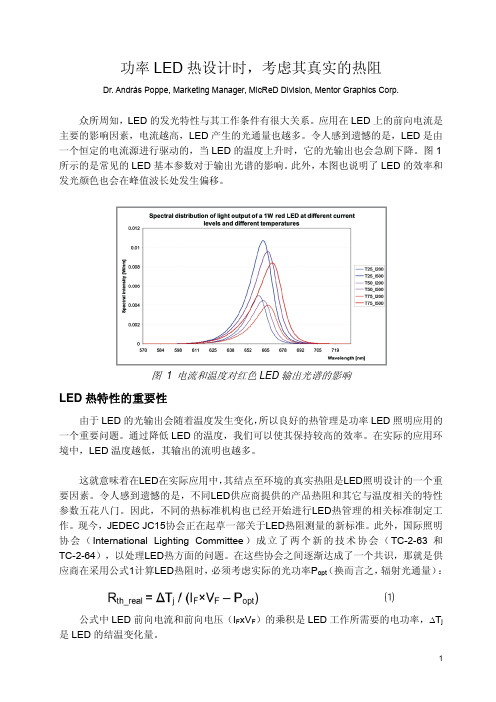
功率LED热设计时,考虑其真实的热阻Dr. András Poppe, Marketing Manager, MicReD Division, Mentor Graphics Corp.众所周知,LED的发光特性与其工作条件有很大关系。
应用在LED上的前向电流是主要的影响因素,电流越高,LED产生的光通量也越多。
令人感到遗憾的是,LED是由一个恒定的电流源进行驱动的,当LED的温度上升时,它的光输出也会急剧下降。
图1所示的是常见的LED基本参数对于输出光谱的影响。
此外,本图也说明了LED的效率和发光颜色也会在峰值波长处发生偏移。
图 1 电流和温度对红色LED输出光谱的影响LED热特性的重要性由于LED的光输出会随着温度发生变化,所以良好的热管理是功率LED照明应用的一个重要问题。
通过降低LED的温度,我们可以使其保持较高的效率。
在实际的应用环境中,LED温度越低,其输出的流明也越多。
这就意味着在LED在实际应用中,其结点至环境的真实热阻是LED照明设计的一个重要因素。
令人感到遗憾的是,不同LED供应商提供的产品热阻和其它与温度相关的特性参数五花八门。
因此,不同的热标准机构也已经开始进行LED热管理的相关标准制定工作。
现今,JEDEC JC15协会正在起草一部关于LED热阻测量的新标准。
此外,国际照明协会(International Lighting Committee)成立了两个新的技术协会(TC-2-63和TC-2-64),以处理LED热方面的问题。
在这些协会之间逐渐达成了一个共识,那就是供应商在采用公式1计算LED热阻时,必须考虑实际的光功率P opt(换而言之,辐射光通量):公式中LED前向电流和前向电压(I F xV F)的乘积是LED工作所需要的电功率,∆T j 是LED的结温变化量。
当确定LED热阻的时候忽略光功率会得到比LED实际应用更低的热阻。
如果LED 照明设计师使用这些数据去计算LED灯的光输出量,其结果是他们的设计往往无法满足实际的光输出量的要求。
CREE_LED_热设计_Thermal_Manager
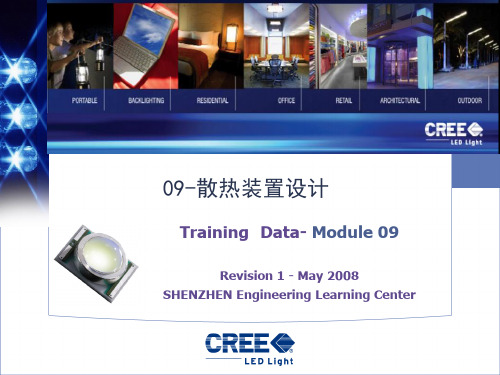
pg. 28
项目 电流
参数 350~1000
环境温度
27~29
TIM
3.8
型号 Xlamp7090 ECB-00412-01-GP T-pcm 580
数量 1 1 1
单位 mA
尺寸
℃
W/mK 厚度=0.127mm
pg. 24
测试结果 – 矩形 PCB
Thermal Resistance (ºC/W) '
20 19 18 17 16 15 14 13 12 11 10
%
)
Copyright © 2008, Cree, Inc.
寿命(小时)
pg. 8
结温和正向电压
• LED温度系数 – -mV/°C(负温度系数)
• 结温Tj上升,LED的正向电压降低
例: 10 LED 串联 正向电压Vf (@ Tj =25℃) = 3.3V 总电压 = 10 * 3.3 = 33V 当结温 Tj = 60 ℃时 正向电压Vf = 3.3 –(.004*35) = 3.16V 总电压 = 10*3.16 = 31.6V
Most high power LED lamps will need a heat sink in order to dissipate operating heat.
Extruded
Recommended thermal management products include:
• Thermally conductive compounds
pg. 19
介绍 FR4 PCB的热传导
Copyright © 2008, Cree, Inc.
LED的热量通过敷铜和金属化过孔传到线 路板(PCB)的背面
PHILIPS(飞利浦)_LED光源散热设计指南
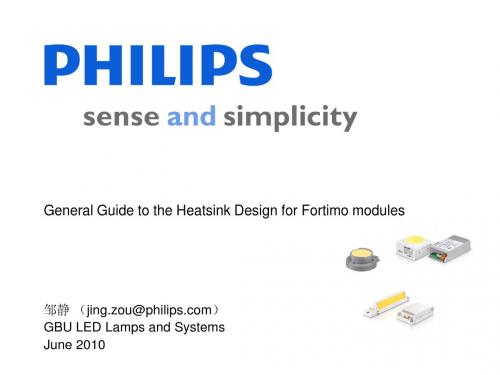
转换成光的效率
Remote Phosphor Tc (篊) < P Optical (W) Power module only [Watt] 14.65 32.8 9.24 32.8 8.57 32.8 WPE
Open 4000K 3000K
55 55 55
44.71% 28.17% 26.13%
1-45% = 55% 的功率转换成热! 1-26% = 74% 的功率转换成热! 11
Confidential
GBU LED Lamps and Systems, June 2010
21
样例: 模拟的天花板环境中Tc的测量
Box dimensions: 1x1x1 m Height above ceiling: 0.35 m Ambient temperature above ceiling: 35°C Box temperature is controlled with liquid cooled wall and a thermostat bath
环境温度
• 热阻(Rth)如下: Rth= ∆T/Pheat = 1/ (h* Aeff* )
Confidential
GBU LED Lamps and Systems, June 2010
15
主动散热和被动散热的比较:
Comparison between passive and active cooling Natural convection Forced Convection 利用自然空气对流 需要工具迫使空气对流,要消耗能量 没有噪音 可能会产生一些噪音 热对流系数比较小 热对流系数相对较大 相对大而重的散热器 相对小巧的散热器
GBU LED Lamps and Systems, June 2010
LED照明模块整体散热处理
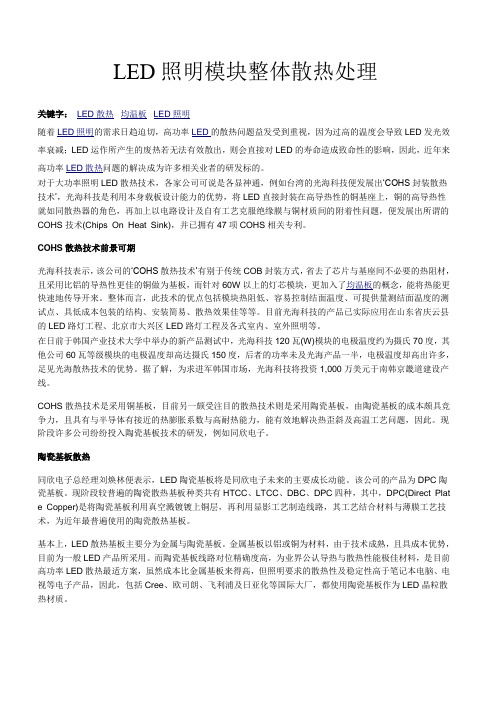
LED照明模块整体散热处理关键字:LED散热均温板LED照明随着LED照明的需求日趋迫切,高功率LED的散热问题益发受到重视,因为过高的温度会导致LED发光效率衰减;LED运作所产生的废热若无法有效散出,则会直接对LED的寿命造成致命性的影响,因此,近年来高功率LED散热问题的解决成为许多相关业者的研发标的。
对于大功率照明LED散热技术,各家公司可说是各显神通,例如台湾的光海科技便发展出‘COHS封装散热技术’,光海科技是利用本身载板设计能力的优势,将LED直接封装在高导热性的铜基座上,铜的高导热性就如同散热器的角色,再加上以电路设计及自有工艺克服绝缘膜与铜材质间的附着性问题,便发展出所谓的COHS技术(Chips On Heat Sink),并已拥有47项COHS相关专利。
COHS散热技术前景可期光海科技表示,该公司的‘COHS散热技术’有别于传统COB封装方式,省去了芯片与基座间不必要的热阻材,且采用比铝的导热性更佳的铜做为基板,而针对60W以上的灯芯模块,更加入了均温板的概念,能将热能更快速地传导开来。
整体而言,此技术的优点包括模块热阻低、容易控制结面温度、可提供量测结面温度的测试点、具低成本包装的结构、安装简易、散热效果佳等等。
目前光海科技的产品已实际应用在山东省庆云县的LED路灯工程、北京市大兴区LED路灯工程及各式室内、室外照明等。
在日前于韩国产业技术大学中举办的新产品测试中,光海科技120瓦(W)模块的电极温度约为摄氏70度,其他公司60瓦等级模块的电极温度却高达摄氏150度,后者的功率未及光海产品一半,电极温度却高出许多,足见光海散热技术的优势。
据了解,为求进军韩国市场,光海科技将投资1,000万美元于南韩京畿道建设产线。
COHS散热技术是采用铜基板,目前另一颇受注目的散热技术则是采用陶瓷基板,由陶瓷基板的成本颇具竞争力,且具有与半导体有接近的热膨胀系数与高耐热能力,能有效地解决热歪斜及高温工艺问题,因此。
- 1、下载文档前请自行甄别文档内容的完整性,平台不提供额外的编辑、内容补充、找答案等附加服务。
- 2、"仅部分预览"的文档,不可在线预览部分如存在完整性等问题,可反馈申请退款(可完整预览的文档不适用该条件!)。
- 3、如文档侵犯您的权益,请联系客服反馈,我们会尽快为您处理(人工客服工作时间:9:00-18:30)。
Copyright 2008, Cree, Inc.
pg. 20
用于MCPCB 功率 LEDs用于 用于
一般功率 LED
引线支架和热沉连接
+
LED 电路
+
Tied cathode requires board-level isolation of thermal path (More expensive!)
Copyright 2008, Cree, Inc. pg. 11
差的 和 良好的热设计
良好的热设计 –结温Tj <85°C 结温T 结温 <85° –热沉装置 热沉装置 差的热设计 –周围无散热表面 周围无散热表面 –结温Tj >85°C 结温T 结温 >85°
Copyright 2008, Cree, Inc.
20
Thermal Resistance (C/W) '
19 18 17 16 15 14 13 12 11 10 0 200 400 600 800 1000 1200
2.95% 0.96% 0.46% 0.70%
MCPCB FR4
Current (mA)
Copyright 2008, Cree, Inc.
Copyright 2008, Cree, Inc.
pg. 10
Thermal Management Products
Types of Heat Sinks Most high power LED lamps will need a heat sink in order to dissipate operating heat. Recommended thermal management products include:
200 mA 350 mA 450 mA
一般而言, 后基本达到热 一般而言 开启20 分钟(1200 sec) 后基本达到热平衡 有一个能较长时间工作的好的热 较长时间工作的好的 必须有一个能较长时间工作的好的热沉
Copyright 2008, Cree, Inc.
pg. 14
2) 测焊点温度 测焊点温度
数量 1 1 1
测试装置 测试装置
LED 热模块 TIM Tb Rba 项目 电流 环境温度 TIM
Ta
厚度=0.127mm
** Cooler Master Co., Ltd.初步测试结果
Copyright 2008, Cree, Inc. pg. 24
测试结果 测试结果 – 矩形 PCB
20
Thermal Resistance (C/W) '
XLamp
+
隔离热通道
LED 电路
+
-
FR4
敷铜层
铜热过孔
其独特的热电分离 如图所视的设计 其独特的热电分离, 设计XLamp没有任何问题 没有任何问题 热电分离 没有任何 用FR4设计要求热密度 < 1 W/in2 设计要求 设计要求热
Copyright 2008, Cree, Inc.
pg. 23
XLamps ~50000hrs@Tj<80'C
Copyright 2008, Cree, Inc.
pg. 3
LED光输出与结温关系 LED光输出与结温关系
Copyright 2008, Cree, Inc.
pg. 4
LED 的节点温度
LED的节点温度 的节点温 的节点 芯片节点处是LED发光的唯一来源. 芯片节点处是LED发光的唯一来源. 芯片节点处是LED发光的唯一来源 在导通电流发光状态下,节点区域将变得非常热. 在导通电流发光状态下, 在导通电流发光状态下 节点区域将变得非常热.
当LED在长时间处于高温工作 当LED在长时间处于高温工作 状态下,将会影响光输出及 状态下,将会影响光输出及使 用寿命. 用寿命.
对于LED的结温能产生影响的因数有 对于LED的结温能产生影响的因数有: LED
室温下的LED周围的环境温度 室温下的LED周围的环境温度 LED 热系统的构造组成及导热材料的热阻 通过LED的电流大小 通过LED的电流大小 LED
结温 [Tj] = [焊点温度 (Tsp)] + ( [Rth j-sp] x [功率 ) 功率] 焊 功率 例: 51.2°C + (8°C/W x 1.155 W) = 51.2 + 9.24 = 60.44°C ° ° °
Copyright 2008, Cree, Inc.
pg. 18
热传导
Copyright 2008, Cree, Inc. pg. 6
何处是LED PN结 何处是LED PN结?
LED PN结 结
LED PN结位于 LED 芯片内部 结 LED 结温 (Tj) 无法直接测量 无法直接测
Copyright 2008, Cree, Inc.
pg. 7
为什么LED 很重要? 为什么LED 结温 Tj 很重要?
+
-
FR4
敷铜层
铜导热过孔
FR4 单独提供不了热通道 –必须增加敷铜面积和热过孔 独提供不了热 热过孔 必 增加敷铜 散热层本身是导电性的 ,将导致LED之间短路 热层本身是导电性的 将 本身是导电 之
Copyright 2008, Cree, Inc.
pg. 22
XLamp 用 FR4工作 工作! 工作
pg. 26
摘要
LED 结温 影响 LED 寿命和光通量维持 影响正向电压 不可能直接测量. 必须通过其他的方法测温. LED Tj 不可能直接测量. Tj 必须通过其他的方法测温.
如何测结温 1. 等 LED(s) 达到热平衡 2. 测焊点温度 3. 测电压和电流 结温Tj 4. 计算功率和 结温Tj 热过孔 有与MCPCB MCPCB相似的热阻 FR4 PCB 有与MCPCB相似的热阻 用热过孔的FR4 比MCPCB便宜 用热过孔的FR4 MCPCB便宜
寿命和长 结温(Tj )影响LED寿命和长期流明维持 寿命和 期流明维
相 对 光 通 量 ( % ) 寿命(
Copyright 2008, Cree, Inc.
Tj (°C) °
L70 97,000 55,000 32,000
X + 10°C ° + 20°C °
X X + 10 X + 20
)
Copyright 2008, Cree, Inc.
pg. 2
散热好坏直接关系LED寿命及光输出 散热好坏直接关系LED寿命及光输出 LED
在大功率 在大功率LED中,散热是个大问题.若不加散热措施,则大功率 在大功率 中 散热是个大问题.若不加散热措施,则大功率LED的器芯温度会 的器芯温度会 急速上升,当其结温(TJ)上升超过最大允许温度时(一般是150℃),大功率 急速上升,当其结温( )上升超过最大允许温度时(一般是 ℃),大功率 LED会因过热而损坏.因此在大功率 会因过热而损坏. 灯具设计中, 会因过热而损坏 因此在大功率LED灯具设计中,最主要的设计工作就是散热 灯具设计中 设计. 设计.
pg. 16
3) 测电压和电流 测电压和
两端的电压和流过 测量LED两端的电压和流过的电流 两端的电压和流
Copyright 2008, Cree, Inc.
pg. 17
4) 计算功率和结温 算功率和结
功率 [功率 P(W)] = [电压 电压(V)] x [电流 (A)] 功率 电压 电 例: 3.3V x 0.35 A = 1.155 W
Copyright 2008, Cree, Inc.
pg. 9
如何散热(如何获得低热阻 低结温 如何散热 如何获得低热阻&低结温 如何获得低热阻 低结温)
良好的散热材料. 良好的散热材料. 散热面积大小与散热成正比. 散热面积大小与散热成正比. 整个散热通路没有瓶颈. 整个散热通路没有瓶颈.
19 18 17 16 15 14 13 12 11 10 0 200 400 600 800 1000 1200
1.47% 1.82% 0.88% 1.88%
MCPCB FR4
Current (mA)
Copyright 2008, Cree, Inc.
pg. 25
测试结果 星形PCB 测试结果 – 星形
pg. 8
结温和正向电压
LED温度系数 LED温度系数 – -mV/°C(负温度系数) mV/° 负温度系数) 结温Tj上升,LED的正向电压降低 结温Tj上升,LED的正向电压降低 Tj上升
例: 10 LED 串联
正向电压Vf =25℃ 正向电压Vf (@ Tj =25℃) = 3.3V 总电压 = 10 * 3.3 = 33V 当结温 Tj = 60 ℃时 正向电压Vf 正向电压Vf = 3.3 –(.004*35) = 3.16V (.004*35) 总电压 = 10*3.16 = 31.6V ★这事例说明采用恒流驱动是非常重要的
09-散热装置设计
Training Data- Module 09
Revision 1 - May 2008 SHENZHEN Engineering Learning Center
目录 高功率LED特性和热的关系 高功率LED特性和热的关系 LED –光输出和结温 Tj关系. 光输出和结温 关系. 关系. 寿命和结温 Tj关系. –正向电压Vf和结温 Tj关系. 正向电压V 关系. 正向电压 如何测量结温Tj 如何测量结温T 热传导
几乎无法直接测焊点 几乎无法直接测焊点 测焊 温度传感器直接在LED周边PCB传热良好处测量 传热良好处测量 温度传感器直接在 周 传热良好处测
Copyright 2008, Cree, Inc.
